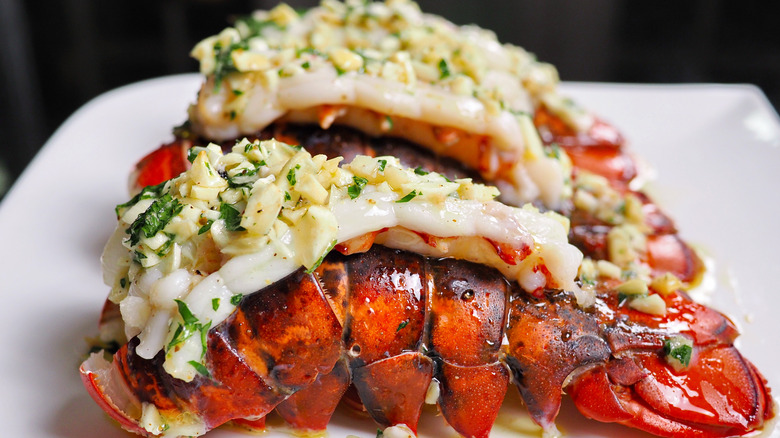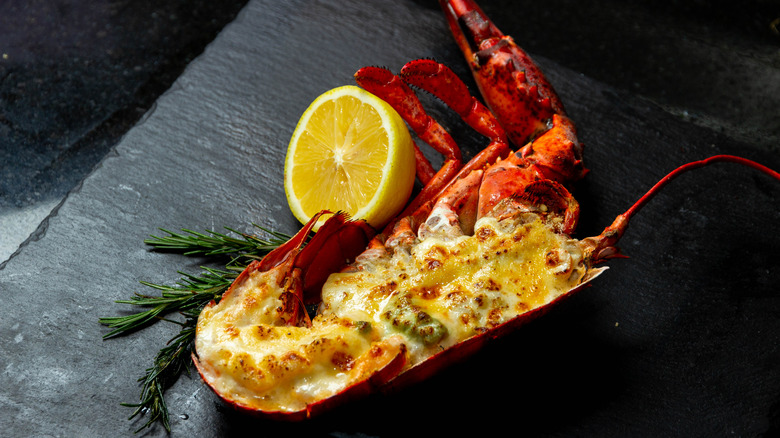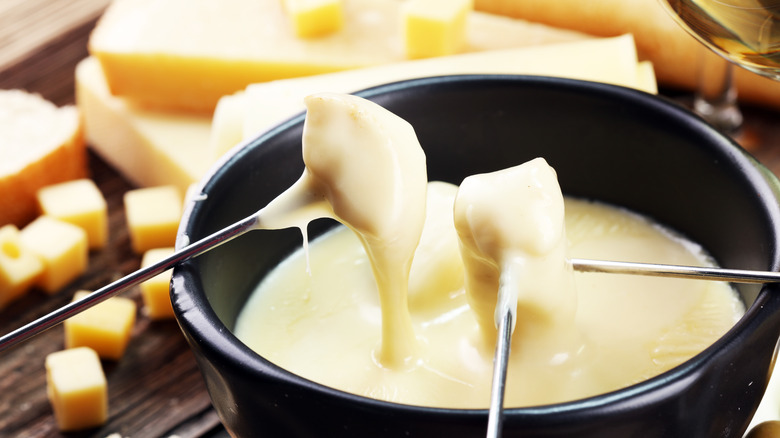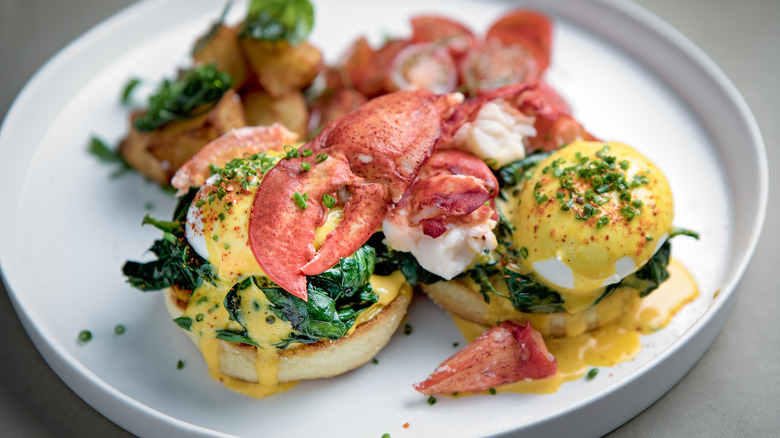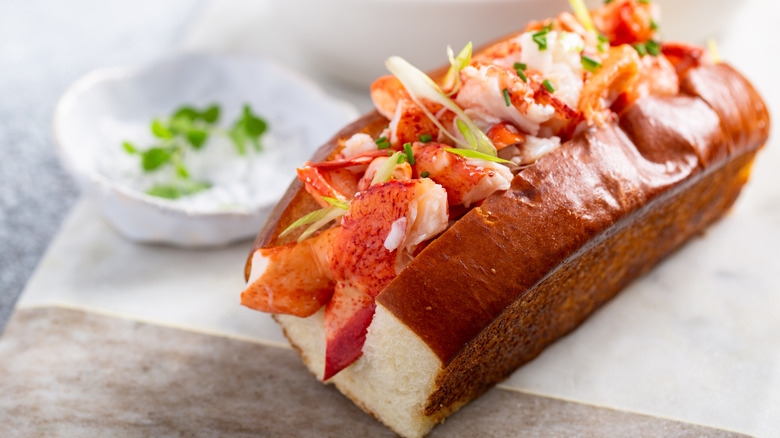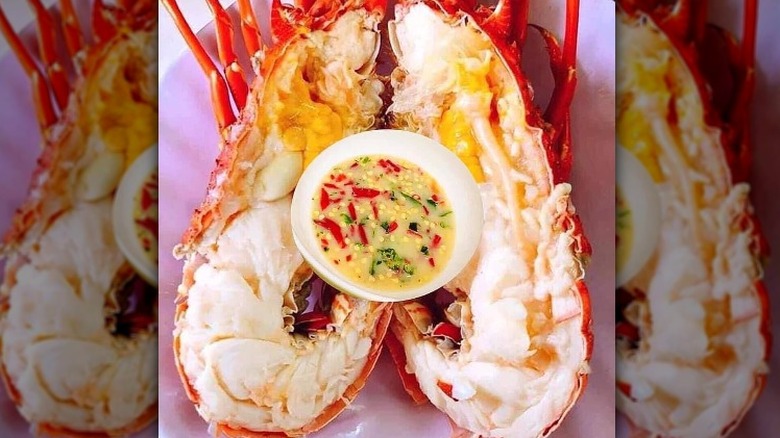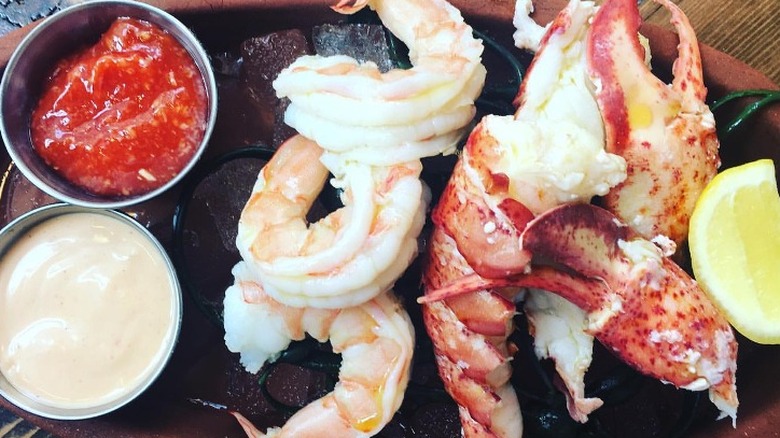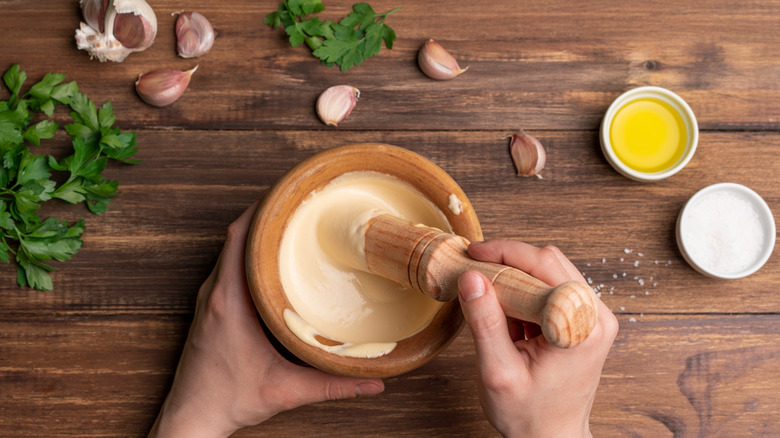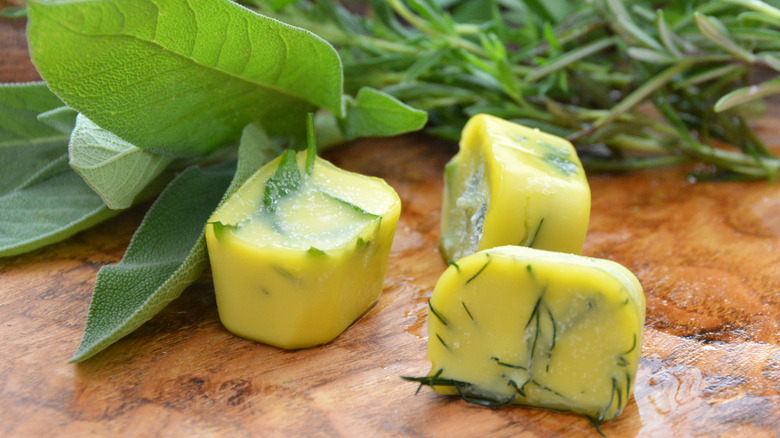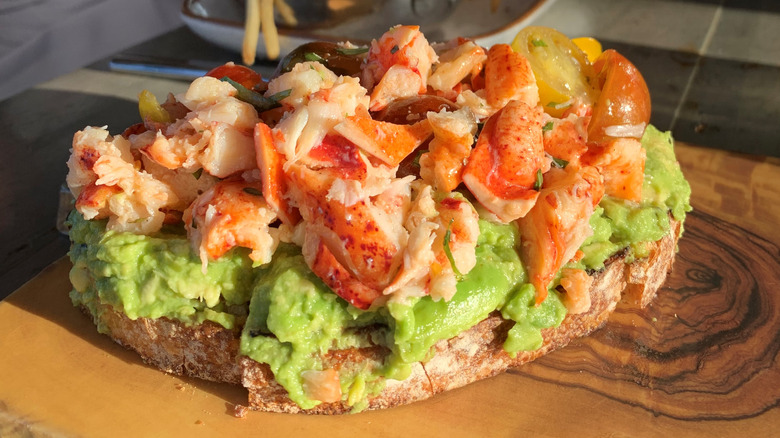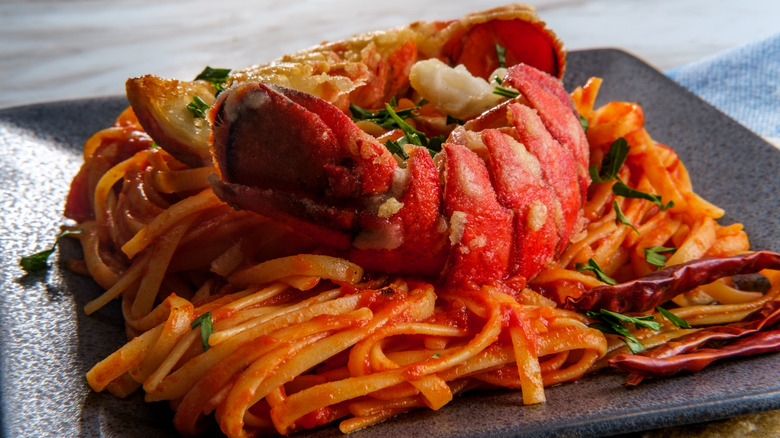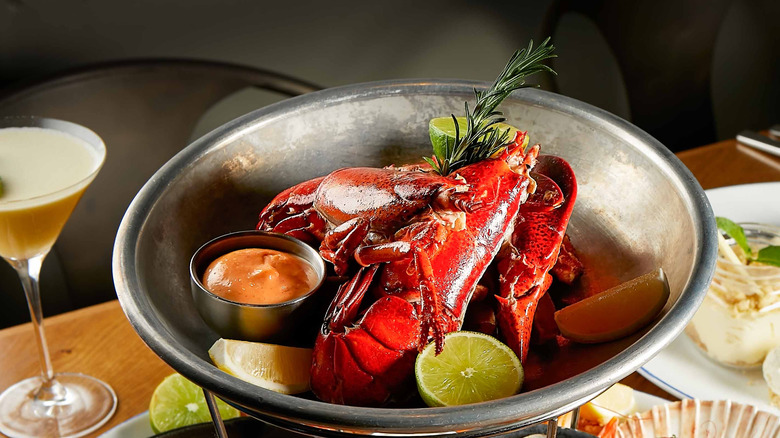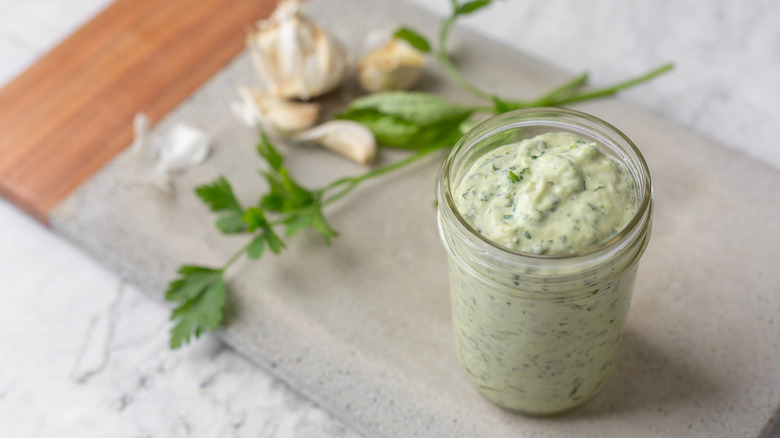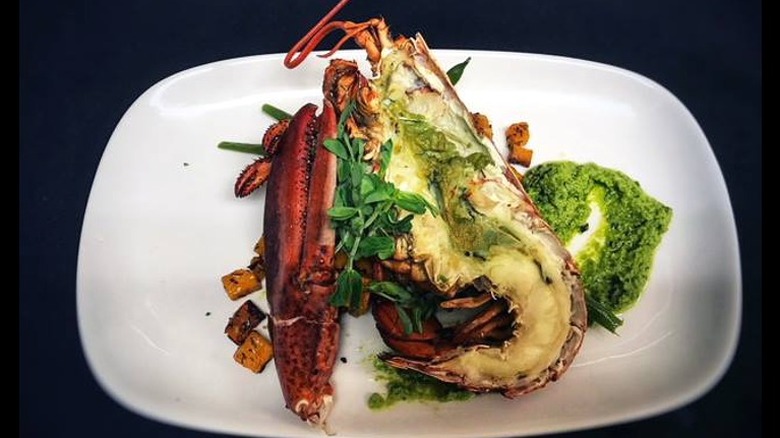13 Best Sauces To Dip Lobster In That Aren't Plain Butter
Sweet, succulent, tender lobster meat has a luscious flavor similar to crab, with a toothsome texture like jumbo prawns but is lighter, cleaner, and more decadent. Lobster often lands at the top of the list of high-end indulgent delicacies served alongside steak in a surf and turf on special occasions with a ramekin of clarified butter on the side. It's also at home in a Southern cajun lobster boil paired with sweet corn, crawfish, shrimp, and butter.
Deciding what type of lobster meat you want to enjoy is essential to your enjoyment. The meaty difference between spiny and Maine lobsters is that cold-water American lobsters will be sweeter and more tender than warm-water lobsters from the Caribbean. The sweetness is likely why the Maine lobster industry is the largest globally, worth over $500 million annually in Maine alone, (via Visit Maine).
The state showcases an array of offerings to highlight the rich and decadent flavors of the crustacean, from a lobster roll, pot pie, risotto, mac and cheese, and more. Though boiling or steaming whole lobster, cracking open the shell, scooping out the tender meat, and dunking it in clarified butter may be the easiest way to enjoy lobster, it isn't the only sauce that pairs with the succulent meat. We have compiled a delicious list of alternatives to make your lobster feasts complete.
Thermidor sauce
The sauce for the classic dish, lobster Thermidor, is as rich as its history. Some say it dates back to Napoleon, who is said to have named the lobster dish after the warm month in the French Republic calendar during which the delicacy was enjoyed. Other theories say the offering originated in the late 1800s when a French restaurant named a new offering with wine and cheese after a hot new play showing at the theater next door. Either way, the warm and creamy Thermidor sauce became one of the most popular dishes in America through the early to mid-1900s.
To create the Thermidor sauce, prepare the sauce by boiling or steaming whole lobsters until barely cooked. The lobster meat is removed from the shell, keeping the outside intact. The shellfish is then classically mixed with cognac, egg yolks, cream, and mustard. The meat is then stuffed back into the shell and topped with a pile of cheese — typically a nutty, slightly earthy gruyere. A quick broil of the combination melts the cheese to create a toasty brown crust atop a pile of decadent lobster indulgence. You can still find the classic dish on fine-dining menus across the country, where it has been enjoyed during special occasions for generations. But we say enjoy it any time of the year, pairing it with a crisp glass of Champagne.
Cheese fondue
Swiss-style cheese fondue is as good today as in the 1960s and '70s. At the time, diners would gather around communal fondue pots bubbling with gooey melted cheese paired with platers of bread, protein, and vegetables for dipping into the sauce. Then, like now, the most decadent option to include on the end of the fondue fork is lobster.
Though cheese and fish aren't a common pairing, the combination works well with the lobster due to the shellfish's delicate flavors combined with the nuttiness of the gruyere and the creaminess of fontina, enhancing the savory richness of the fish. The flavors remain balanced thanks to the addition of white wine, which adds a pop of acidity and freshness to the indulgently gooey cheese sauce.
We recommend steaming whole lobsters in their shells to prepare a classic cheese fondue, then, remove the meat from the body and cut it into 2-inch cubes to easily slide each bite-sized nugget onto the fork. Serve with chunks of toasted bread, roasted red potatoes, and peppery vegetables like radishes to cut through the decadence of the retro dish.
Hollandaise
Take your Sunday brunch up an indulgent notch by enjoying lobster eggs Benedict with a lemony hollandaise sauce. One of the five mother sauces of French cuisine, the egg, butter, and lemon juice-based sauce has been topping the breakfast dish since the 1860s when New York's Delmonico's restaurant first poured the sauce over poached eggs Benedict.
Today, hollandaise is a traditional accompaniment to lightly poached seafood. The emulsified sauce's rich and tangy qualities complement the fish's fresh flavors. We know the classic preparation of constantly whisking eggs and butter in a bowl over boiling water can be daunting, so save yourself the headache by employing a blender to create an easy hollandaise sauce for the comforting morning dish.
If you prefer the grassy flavor of fresh herbs, swap the hollandaise with a classic béarnaise sauce. Béarnaise beams with slightly sweet, licorice-filled tarragon and oniony shallots, elevating the lobster's luxurious flavor.
Kewpie mayonnaise
Your lobster roll is incomplete without the addition of mayonnaise. Combining mayo with lobster accentuates the sweetness of the shellfish, adding fatty richness to the luxurious crustacean. When deciding between the Japanese offering of Kewpie mayo and regular mayonnaise, Kewpie is hands-down our favorite. Kewpie mayonnaise is an uber-unctuous sauce that uses four egg yolks in every 500 grams of mayonnaise. The protein-packed yolks are savory and rich, making the spread thick, mouthwatering, and indulgent.
Kewpie then adds a layer of umami that accentuates its extra eggy richness. The umami note comes from including MSG, or monosodium glutamate, in the spread. MSG is a proven safe ingredient, delivering the fifth taste element of umami to the creamy spread's slightly sweet and sour flavors. The original Japanese version of Kewpie contains a flavor enhancer, whereas the American version does not. If you want the real thing, we recommend you read the label next time you buy Kewpie.
Nouc cham sauce
Sweet and sour sauces have been complementing meats and vegetables worldwide for generations.
We love the Vietnamese sauce nouc cham for dipping freshly steamed lobster or Vietnamese-style summer rolls packed with lobster. The sauce has tangy, sweet, and sour flavors due to its combination of vinegar and lime juice, which brings acidity, with sugar providing sweetness. Additional ingredients like Thai chiles or sambal oelek provide heat, with green onions and cilantro adding freshness. The final addition of fermented fish sauce provides a funky salty layer of umami, tying together the flavors of the nouc cham sauce.
Pairing the sauce with lobster enhances the lobster's succulence, boosting the meat's sweetness while highlighting the briny saltiness of the ocean-grown crustacean. Conversely, the sour notes in the sauce cut through the richness of the shellfish. We recommend using lobster tail meat with a red nouc cham sauce. The tail meat is slightly denser than the claws and body of the fish, which will stand up to the extra pop of heat from the sauce (if you include sriracha in your recipe).
Cocktail sauce
There is something so appealing about the combination of shellfish with classic cocktail sauce. The tangy, spicy sweetness of the ketchup-based sauce has been topping crustaceans and bivalves since the 19th century when a gold miner in San Francisco first put the combination together. The story goes that the miner took a shot of whiskey and then poured a raw oyster, Worcestershire, hot sauce, lemon, and ketchup into the glass, creating the first oyster shot.
The cocktail sauce name comes from the vessels used to serve the appetizer. During prohibition in the United States, cocktail glasses became the go-to vessel for serving the dish as glasses found an alternative use. The shrimp cocktail served in a coupe, wine, or martini glass was the ultimate start to any fancy dinner party.
The American condiment is perfect for lobster as its acidity from the lemon and tomato sauce and heat from the horseradish, and hot sauce will cut through the richness of the succulent lobster. The umami notes from Worcestershire add depth to the flavor combination. As cocktail sauce flavors are robust, overdoing a cocktail sauce can be a red flag. The purpose of any sauce is to complement, not overwhelm, so we recommend dipping sparingly.
Aioli
Aioli is much more than just a flavored type of mayonnaise. Unlike mayonnaise, the classic aioli recipe is only garlic and olive oil seasoned with salt. The original combination contains no egg, vinegar, or lemon juice, and no mustard, pepper, or other seasonings.
The creation of aioli starts with whole garlic cloves that are mashed with salt to create a paste. You then slowly whisk in the olive oil, drop by drop. The result is a thick, naturally emulsified sauce with a spicy, pungent garlicky flavor and rich golden yellow color. As it is a simple combination of monounsaturated fat-filled olive oil and immune-boosting raw garlic, authentic aioli is a part of the heart-healthy Mediterranean diet.
Today's pre-packaged aioli options often include eggs, spices, and vinegar, making them more like mayonnaise than the historical sauce. However, these additional flavorings include options that also pair perfectly with lobster, infusing savory qualities to create aioli with truffle, wasabi, sriracha, pesto, or our favorite, garlic aioli. Whether you serve the classic aioli or a flavored option, each will enhance the savory qualities of the tender crustacean while adding a pop of flavor to the delicate meat.
Flavored butter
Much like an aioli, dipping lobster in seasoned butter will enhance the sweetness of the shellfish, infusing flavor while boosting the tenderness of the moist meat. Creamy, rich butter is the ideal carrier for herbs and spices that dissolve into the spread. When we taste the combination, our mouths begin to water, sending waves of enjoyment from our tongues to our brains. Adding aromatic flavorings to the butterfat-filled condiment will enhance the tasting experience engaging our senses.
For instance, whisking a few drops of truffle oil into butter will give lobster an aromatic, earthy truffle-like flavor without overpowering the dish. Blending garlic and parsley with softened butter creates a simple three-ingredient garlic butter that will lift the lobster's mild taste. The herbaceous condiment adds a punchy savory, fresh element to the meat to create a well-rounded, satisfying bite of lobster.
In a classic beurre blanc sauce, white wine, vinegar, and shallots are simmered in butter, infusing acidity, and earthy oniony flavor into creamy whole butter. The resulting sauce is smooth, rich, and velvety, with a tangy bite that compliments the fish. Poaching lobster in a beurre blanc sauce is a traditional use of the sauce. It is also delicious when served on the side for dipping.
Avocado spread
Fresh steamed lobster turns your morning avocado toast into a decadent delight to start the day. The creaminess of avocado melds with the richness of lobster, whether serving the combo on toast, with greens, or when dipping the meaty crustacean into the sauce on its own.
Not to be confused with the Mexican condiment that is often served alongside salsa, avocado spread differs from guacamole because it contains only mashed avocados and lemon or lime juice with a dash of salt, producing a buttery, grassy, fresh flavor without the heat or spice of guacamole. The spread is preferable with lobster to ensure the meat's sweetness isn't masked by guacamole's spicy flavors.
The fruit brings a buttery flavor and luscious texture that is the perfect complement to lobster you probably haven't thought of before. In fact, if you're making a side of potatoes for your lobster dish, lean into the Mexican flavors that often go with avocado and season your potatoes as such.
Spicy marinara
The Italian American dish fra diavolo has been a New York staple since 1908 when a restaurant in Little Italy served a spicy sauce atop spaghetti with lobster. Though other seafood like shrimp, clams, or mussels can take on the sauce, the original and best option will always be lobster.
Succulent lobster adds a delicate sweetness and mild shellfish flavor to the spicy marinara that layers tomato, olive oil, and oregano with fiery red pepper flakes. Adding the chili flakes provides notable intense heat in the dish, unlike any other Italian favorite.
Fra diavolo is a hands-on dish as the lobster traditionally comes to the table inside its shell, meaning you will likely get a little messy to enjoy fully. We recommend cracking the shellfish open and digging the flavorful, spicy meat out of the shell with your fingers. Thankfully, most restaurants still offer the attractive lobster bib to protect your shirt from becoming a tomato-splattered mess. If the thought of wearing your dinner is a little much and you prefer to dine without pasta sauce on your fingers, we suggest using the spicy marinara sauce as a dip for toasted lobster ravioli.
Remoulade
Nothing is better with lobster meat than umami-laden, herbaceous remoulade sauce. Like a tartar sauce with capers instead of pickle relish, remoulade sauce has been slathered on po boy sandwiches and served alongside fish cakes throughout creole Louisiana for generations. The sauce's origins are French, but today it is more commonly associated with New Orleans, where it first appeared on the menu of the historic Arnaud's Restaurant shortly after the restaurant opened in 1918, served then and today with shrimp.
The sauce's spicy heat cuts through the fatty richness of the succulent fried lobster meat. The salty, herbaceous qualities of the remoulade bring out the meat's savory notes. In New Orleans, the remoulade sauce received its pink hue thanks to the addition of ketchup, hot sauce, and paprika. These flavorings combine with mayonnaise, capers, garlic, and herbs to become a flavor-packed herbaceous, spicy condiment that creates a mouthwatering combo when paired with lobster. Load the duo in a soft toasted roll for the ultimate lobster po boy to transport you to the Big Easy.
Green goddess dressing
The origin of green goddess dressing dates back almost 100 years, when herbs, oil, and egg yolks were whisked together with umami-packed anchovies to create a savory fresh sauce for salads and vegetables at the Palace Hotel in San Francisco. The inspiration for the sauce came from the court of King Louis XIII, where it was served with grilled eel. Today, we prefer it with meaty grilled or steamed lobster tails.
Green goddess dressing combines fragrant herbs, like minty, lemony basil, oniony chives, and licorice-filled tarragon, adding a zesty zing to enhance the mild flavor and sweetness of the lobster. At the same time, the mayonnaise base brings creaminess to the tender, delicate meat.
Over the years, avocado has been substituted for mayonnaise, making the dressing slightly greener while enhancing the sauce's grassy, vegetal taste. We prefer including both mayo and avocado, ensuring the sauce has a velvety texture and loads of herbaceous flavor.
Spring pea pesto
The natural sugars in fresh spring vegetables, like baby sweet peas, have a sweetness that harmonizes with moist, tender, and mild lobster. Spring peas enhance the lobster's delicate character, highlighting the shellfish's fresh and light flavor.
We love the combination of lobster with our pea pesto with ricotta. The subtle creaminess from the Italian cheese brings a creamy, decadent note to the delicate fish. Fresh spring peas are delicious when in season. However, you can easily use defrosted frozen peas for a quick and easy swap that creates a similar grassy vegetable flavor identical to fresh peas.
We love the pesto with the claw meat from the lobster. The claw meat is softer and milder in flavor than the tail, as the claws are not utilized as much throughout the lobster's life. The lobster can also drop its pincer claw in defense if attacked. The shellfish will grow the leg back over time. When it does, the meat will be much more tender and delicate than the rest of the body.
